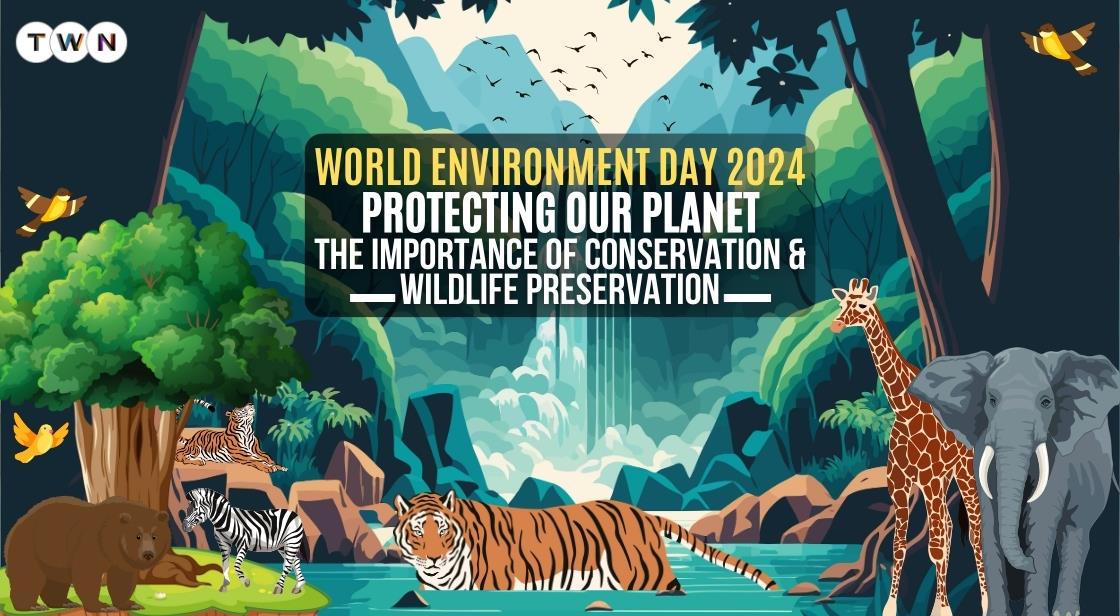World Environment Day 2024: The Importance of Conservation and Wildlife Preservation

Blog Post
In an age defined by unprecedented urban expansion, industrial growth, and the looming specter of climate change, World Environment Day, observed annually on June 5th, serves as a critical reminder of our collective responsibility towards the environment.
While we celebrate the beauty and diversity of our planet, we must also acknowledge the pressing need for conservation and wildlife preservation.
As human populations surge and cities sprawl, natural habitats are increasingly fragmented and degraded, placing immense pressure on delicate ecosystems worldwide. The consequences of unchecked exploitation and habitat destruction are dire, with countless species facing extinction and irreversible damage to the intricate web of life that sustains us all.
Biodiversity, the rich tapestry of life forms that inhabit our planet, is not merely a source of wonder and fascination; it is the very foundation of our existence. From the microscopic organisms that enrich our soils to the majestic apex predators that regulate entire ecosystems, every species plays a crucial role in maintaining the delicate balance of nature.
Yet, in our relentless pursuit of progress and economic growth, we often overlook the irreplaceable services provided by healthy ecosystems, from purifying air and water to mitigating the impacts of climate change. Moreover, the effects of climate change are exacerbating the challenges faced by already vulnerable species and ecosystems.
Rising temperatures, shifting precipitation patterns, and more frequent extreme weather events are driving species to the brink of extinction and causing widespread disruption to ecosystems worldwide.
Building on the foundation laid by World Environment Day, let's use this occasion to propel ourselves towards a future where conservation and wildlife preservation are not just aspirations, but core principles guiding our actions. Individual efforts, from planting trees and reducing waste to supporting renewable energy, combine to create a significant impact.
"Let's work together to ensure a thriving future for our planet, one where both humanity and the myriad forms of life we share it with can flourish."
World Environment Day 2024 Theme
World Environment Day, celebrated annually on June 5th, acts as a global platform to address critical environmental issues. Each year, a specific theme is chosen to raise awareness and inspire action on pressing concerns. For 2024, the theme is Land restoration, desertification, and drought resilience.
This theme highlights the alarming state of our planet's land. According to the UN Convention to Combat Desertification, a staggering 40% of the Earth's land is degraded, impacting the lives of half the world's population. Additionally, droughts are becoming more frequent and severe, with a 29% increase in their number and duration since 2000. The UN warns that without immediate action, droughts could affect over 75% of the global population by 2050.
This year's theme builds upon previous World Environment Day themes:
- 2023: Focused on finding solutions to plastic pollution, a major environmental threat.
- 2022: Emphasized the concept of "Only One Earth," urging humanity to restore balance with nature.
- 2021: Called for urgent global action to revive our damaged ecosystems.
By focusing on land restoration, desertification, and drought resilience in 2024, World Environment Day aims to inspire individuals and communities to take action and promote practices that restore the health of our land and build a more sustainable future for all.
Finding Solutions for Conservation and Wildlife Management
1. The Significance of Conservation and Wildlife Preservation
Definition of Wildlife Conservation
Preserving wildlife from unjustified slaughter and poaching is known as wildlife conservation. Teaching people about the value of wildlife is another way that it includes raising awareness.
To keep the food chain and ecosystem balance, wildlife conservation is crucial. The number of deer rises sharply if all tigers are hunted for their hides. There also wouldn't be a source of eggs if people killed all the hens for meat. Thus, in order to keep animals alive and preserve their place in the food chain and environment, wildlife conservation is essential.
Understanding the Importance of Biodiversity
Biodiversity, encompassing the variety of life forms on Earth, is a fundamental component of our planet's ecosystems. It comprises not only the multitude of species, including plants, animals, and microorganisms, but also the diverse habitats and ecosystems that support them.
Crucial Role in Maintaining Ecological Balance
Biodiversity plays a pivotal role in maintaining ecological balance within ecosystems. Each species, regardless of its size or significance, contributes to the intricate web of life, interacting with other species and their environment in complex ways.
This interconnectedness ensures the stability and resilience of ecosystems, allowing them to withstand environmental changes and disturbances.
Supporting Ecosystem Services
Ecosystems provide a wide range of essential services that support life on Earth, known as ecosystem services. These services include provisioning services (such as food, water, and medicine), regulating services (such as climate regulation, flood control, and pollination), supporting services (such as soil formation and nutrient cycling), and cultural services (such as recreation and spiritual enrichment).
Biodiversity is integral to the functioning of these ecosystem services, as different species fulfill specific roles and functions within ecosystems.
Sustaining Human Well-being
Biodiversity is essential for sustaining human well-being in numerous ways. It directly contributes to food security, providing a diverse array of crops, livestock, and seafood that form the foundation of our diets. Additionally, many pharmaceuticals and medical treatments are derived from natural sources, highlighting the importance of biodiversity for human health.
Moreover, biodiversity enriches our lives culturally and aesthetically, offering recreational opportunities, inspiring artistic expression, and fostering spiritual connections with nature.
Impact of Human Activities on Ecosystems
Despite its critical importance, biodiversity is increasingly threatened by human activities. Deforestation, driven by agricultural expansion, logging, and infrastructure development, results in the loss and fragmentation of natural habitats, leading to the displacement and extinction of countless species.
Pollution, including air and water pollution, chemical contamination, and plastic waste, poses significant threats to biodiversity, poisoning ecosystems and endangering wildlife. Overfishing and exploitation of natural resources deplete fish stocks, disrupt marine ecosystems, and threaten the stability of aquatic ecosystems.
Habitat destruction, combined with climate change, exacerbates the loss of biodiversity, as rising temperatures, changing precipitation patterns, and extreme weather events further disrupt ecosystems and endanger species survival.
Also Read: Easy Ways to Reduce Your Carbon Footprint at Home: Sustainable Living
2. Threats to Conservation and Wildlife Preservation
Conservation and wildlife preservation face numerous threats, including habitat destruction and fragmentation, as well as climate change. These factors significantly impact biodiversity and pose challenges to the survival of many species.
Habitat Destruction and Fragmentation
Urban Expansion and Agricultural Expansion
Urbanization and agricultural expansion lead to the conversion of natural habitats into urban areas, farmland, and industrial zones. This process results in the loss of critical habitats for wildlife, forcing species to adapt to new environments or face extinction.
Logging and Deforestation
Logging activities, including clear-cutting and selective logging, contribute to deforestation and habitat loss. Forest ecosystems, which are home to a vast array of plant and animal species, are particularly vulnerable to degradation and destruction due to logging practices.
Infrastructure Development
The construction of roads, highways, dams, and other infrastructure projects often requires the clearing of large areas of land, leading to habitat fragmentation. Fragmented habitats isolate populations, restrict movement, and reduce genetic diversity, increasing the risk of extinction for many species.
Climate Change and Its Effects on Wildlife
Climate change, driven primarily by human activities and the burning of fossil fuels, is no longer a distant threat. Its escalating impacts are being felt across the globe, disrupting the delicate balance of ecosystems and posing a significant threat to wildlife. Here, we explore some of the most concerning consequences of climate change on the animal kingdom.
1. Habitat Loss and Fragmentation:
Rising temperatures are causing glaciers to melt and sea levels to rise, inundating coastal habitats crucial for numerous species. Warming oceans also lead to coral bleaching, destroying vibrant coral reefs that provide food and shelter for countless marine animals. Additionally, extreme weather events like droughts and wildfires are increasing in frequency and intensity, devastating forests, grasslands, and other vital habitats. Habitat loss and fragmentation not only deprive animals of their homes but also disrupt migration patterns and hinder their ability to find food and mates.
Example: A 2022 study published in Nature Climate Change revealed that rising sea levels threaten to displace over one billion seabirds by the end of the century. This includes iconic species like penguins and albatrosses, whose nesting grounds on low-lying islands are particularly vulnerable.
2. Shifting Food Webs and Disrupted Phenology:
Climate change is altering the delicate balance within food webs. Earlier snowmelt due to warmer temperatures disrupts the timing of insect emergence, leaving vulnerable prey like birds with mismatched breeding cycles and insufficient food for their young. Changes in ocean temperatures are also impacting the distribution of plankton, a critical food source for many marine animals. These disruptions can lead to population declines and even extinctions throughout the food chain.
Example: A 2021 study in Science documented a decline in krill populations in the Antarctic Peninsula, a key food source for whales, penguins, and seals. This decline is linked to rising ocean temperatures and reduced sea ice cover, highlighting the cascading effects of climate change on marine ecosystems.
3. Ocean Acidification:
The oceans absorb a significant portion of the excess carbon dioxide in the atmosphere, leading to a phenomenon called ocean acidification. This acidification makes it harder for shellfish, corals, and other marine organisms to build their shells and skeletons, jeopardizing their survival and the entire marine ecosystem they support.
Example: Oysters, a commercially important shellfish, are particularly vulnerable to ocean acidification. A 2023 study in the journal Global Change Biology found that oyster hatchling survival rates were significantly lower in areas with higher levels of ocean acidity, raising concerns for the future of oyster populations.
4. Range Shifts and the Spread of Disease:
As temperatures rise, some animal species are forced to migrate to cooler regions in search of suitable habitat. However, this is not always possible due to habitat fragmentation or competition with established species. This can lead to population declines and increased competition for resources. Additionally, warmer temperatures can also lead to the spread of diseases carried by insects and other parasites, posing a new threat to wildlife populations.
Example: Polar bears are a prime example of a species struggling to adapt to climate change. The melting sea ice they depend on for hunting seals is diminishing, forcing them to spend more time on land where they have limited access to food. This, in turn, makes them more susceptible to diseases.
5. Effects on Vulnerable Species
Vulnerable species, such as polar bears, coral reefs, and migratory birds, are particularly at risk from the impacts of climate change. Polar bears rely on sea ice for hunting and breeding, but melting ice caps threaten their habitat and food sources.
Coral reefs are sensitive to changes in water temperature and acidity, leading to coral bleaching and ecosystem degradation. Migratory birds face challenges due to habitat loss, changes in migration patterns, and disruptions to food sources along their migratory routes.
3.Conservation Strategies and Initiatives
Conservation strategies and initiatives play a crucial role in protecting biodiversity and preserving ecosystems. Among these, two key approaches are establishing protected areas and wildlife reserves, and implementing community-based conservation projects.
Protected Areas and Wildlife Reserves
Protected areas and wildlife reserves serve as essential refuges for biodiversity, providing habitats for diverse species and safeguarding critical ecosystems. These designated areas include national parks, nature reserves, marine protected areas, and wildlife sanctuaries.
National Parks and Nature Reserves: National parks and nature reserves are designated areas managed for the conservation of ecosystems, wildlife, and cultural heritage. They offer protection to a wide range of species, from iconic megafauna to endangered plants and insects. These areas often have strict regulations to minimize human impact and preserve natural habitats.
Marine Protected Areas: Marine protected areas (MPAs) are designated oceanic regions managed to conserve marine ecosystems, biodiversity, and fisheries resources. They help protect coral reefs, seagrass beds, and other marine habitats, preserving marine biodiversity and supporting sustainable fisheries management.
Wildlife Sanctuaries: Wildlife sanctuaries are areas set aside for the protection of wildlife species, providing refuge for endangered or vulnerable animals. These sanctuaries offer safe havens for threatened species to breed, feed, and thrive without the threat of human interference or exploitation.
Community-Based Conservation Projects
Community-based conservation projects engage local communities in conservation efforts, recognizing their intimate connection with the environment and their role as stewards of natural resources. These initiatives empower communities to participate in conservation activities, promote awareness, and foster sustainable management practices.
Empowering Local Communities: Community-based conservation projects empower local communities to take ownership of conservation initiatives, involving them in decision-making processes and resource management activities.
By recognizing indigenous knowledge and traditional practices, these projects promote culturally sensitive conservation strategies.
Promoting Conservation Awareness: Community-based conservation projects raise awareness about the importance of biodiversity and ecosystems, educating community members about the value of conservation and the threats facing natural habitats and wildlife.
Through workshops, education programs, and outreach activities, these projects promote environmental stewardship and foster a sense of responsibility towards nature.
Fostering Socioeconomic Development: By integrating conservation with socioeconomic development, community-based projects promote sustainable livelihoods and economic opportunities for local communities.
They support ecotourism initiatives, sustainable agriculture practices, and alternative income-generating activities, ensuring that conservation efforts benefit both people and nature.
Enhancing Ecosystem Resilience: Community-based conservation projects contribute to ecosystem resilience by promoting sustainable land use practices, restoring degraded habitats, and mitigating human-wildlife conflicts.
By building partnerships between communities, conservation organizations, and government agencies, these projects foster collaborative efforts to address conservation challenges and protect natural resources for future generations.
4. Role of Technology in Conservation
Technology has become an indispensable tool in the field of conservation, enabling researchers and conservationists to monitor wildlife populations, study habitat changes, and implement effective conservation strategies. This article explores the role of technology in conservation, focusing on wildlife tracking and monitoring systems, as well as the use of drones and satellites in conservation efforts.
Wildlife Tracking and Monitoring Systems
Advancements in Technology
The advent of GPS tracking devices, satellite imagery, and remote sensing technology has revolutionized wildlife tracking and monitoring. These tools provide researchers with unprecedented access to data on animal movements, behavior, and population dynamics, allowing for more accurate assessments of species' status and habitat requirements.
Informing Conservation Strategies
By collecting and analyzing data from wildlife tracking and monitoring systems, researchers can gain valuable insights into the ecological needs of species and ecosystems. This information helps inform conservation strategies and management decisions, such as habitat restoration, protected area design, and wildlife population management.
Use of Drones and Satellites in Conservation Efforts
Monitoring Remote Areas
Drones and satellites are instrumental in monitoring remote and inaccessible areas, where traditional ground-based surveys may be impractical or cost-prohibitive. These technologies provide conservationists with a bird's-eye view of landscapes, allowing them to detect changes in vegetation, land use, and wildlife populations.
Detecting Threats
Drones and satellites play a crucial role in detecting threats to biodiversity, such as habitat loss, deforestation, illegal logging, and poaching activities. By capturing high-resolution imagery and real-time data, these technologies enable conservationists to identify areas at risk and prioritize conservation actions.
Implementing Timely Interventions
One of the key benefits of using drones and satellites in conservation efforts is their ability to facilitate timely interventions. By quickly identifying threats and monitoring conservation initiatives, these technologies enable conservationists to respond rapidly to emerging challenges and implement targeted interventions to protect biodiversity.
5. Most inspiring conservation success stories
The fight for conservation can often feel overwhelming, with stories of habitat loss and endangered species dominating the headlines. However, amidst the challenges, there are remarkable triumphs worth celebrating. Here, we explore some of the most inspiring conservation success stories from around the world, showcasing the power of human intervention and dedication.
1. The Bald Eagle's Soaring Return (North America):
The bald eagle, a majestic symbol of the United States, once faced a perilous decline due to the widespread use of the pesticide DDT, which caused eggshell thinning and reproductive failure. However, thanks to the landmark Environmental Protection Agency ban on DDT in 1972, coupled with dedicated conservation efforts, the bald eagle population has made a remarkable comeback. They were delisted from the Endangered Species Act in 2007, a testament to successful habitat restoration and public support.
2. The Black Rhinoceros's Resurgence (Africa):
Black rhinoceros populations plummeted to alarmingly low levels in the latter part of the 20th century due to rampant poaching for their horns. However, a multi-pronged approach involving stricter anti-poaching measures, community engagement programs, and breeding initiatives has yielded positive results. Black rhino populations have shown a slow but steady increase in recent years, offering a glimmer of hope for this critically endangered species.
3. The Humpback Whale's Epic Recovery (Global):
Humpback whales were hunted to near extinction in the 20th century. However, thanks to a global moratorium on commercial whaling implemented in 1986, their populations have rebounded significantly. These majestic creatures are now regularly sighted in oceans around the world, a testament to the effectiveness of international cooperation in conservation efforts.
4. The California Condor's Climb Back from the Brink (North America):
The California condor, the largest land bird in North America, faced extinction with only 22 individuals remaining in the wild by the mid-1980s. A captive breeding and reintroduction program, combined with efforts to reduce lead poisoning (a major threat from hunters' ammunition), has led to a population increase. Today, over 300 California condors soar through the skies, offering a beacon of hope for critically endangered species worldwide.
5. The Giant Panda's Population on the Rise (China):
The giant panda, an iconic symbol of China, was classified as endangered for decades due to habitat loss and poaching. However, due to significant conservation efforts including establishing protected areas, promoting bamboo forest restoration, and anti-poaching initiatives, the giant panda population has seen a steady increase. In 2021, the International Union for the Conservation of Nature (IUCN) downlisted the giant panda's status from "Endangered" to "Vulnerable," recognizing the progress made in its conservation.
6. Individual Actions for Conservation
Sustainable Living Practices:
-
Reducing Energy Consumption: Individuals can reduce energy consumption by using energy-efficient appliances, turning off lights and electronics when not in use, and utilizing alternative energy sources such as solar or wind power.
-
Minimizing Waste: Adopting practices like recycling, composting organic waste, and avoiding single-use plastics can significantly reduce waste generation and its negative environmental impacts.
-
Conserving Water: Conserving water by fixing leaks, using water-efficient fixtures, and practicing mindful water usage can help preserve this precious resource for future generations.
-
Supporting Sustainable Agriculture: Choosing locally sourced, organic, and sustainably produced food helps support farmers who prioritize environmentally friendly practices such as crop rotation, minimal pesticide use, and soil conservation.
-
Choosing Eco-friendly Products: Opting for products made from recycled materials, biodegradable alternatives, and those with minimal packaging can reduce the ecological footprint associated with consumption.
Supporting Conservation Organizations:
-
Financial Support: Donating funds to reputable conservation organizations helps support their conservation projects, research efforts, and advocacy work aimed at protecting biodiversity and habitats.
-
Volunteering Time and Expertise: Volunteering time and skills for conservation projects, such as habitat restoration, wildlife monitoring, or educational programs, allows individuals to directly contribute to conservation efforts in their communities.
-
Raising Awareness: Sharing information about conservation issues through social media, organizing community events, or participating in outreach programs helps raise awareness and mobilize support for conservation initiatives.
7. Challenges and Future Outlook in Conservation Efforts
Addressing Funding Shortages
Conservation efforts often encounter significant hurdles due to insufficient funding and resource allocation. Limited financial support constrains the scope and effectiveness of conservation initiatives, impeding progress toward biodiversity preservation and ecosystem protection.
Moreover, competing priorities within government budgets and economic constraints exacerbate funding shortages in the conservation sector. To overcome this challenge, concerted efforts are needed to secure sustainable funding streams and mobilize resources for long-term conservation action.
Public-private partnerships, philanthropic support, and innovative financing mechanisms such as conservation bonds and impact investing can help bridge funding gaps and ensure the continuity of conservation efforts.
Adapting to Changing Environmental Conditions
Climate change poses an existential threat to global biodiversity, necessitating adaptive approaches in conservation practices. Accelerating environmental changes, including shifting weather patterns, rising temperatures, and habitat degradation, demand proactive measures to safeguard vulnerable species and ecosystems.
Flexibility and innovation are paramount in developing adaptive management strategies that can effectively respond to evolving environmental conditions. Collaborative initiatives involving scientists, policymakers, local communities, and conservation organizations are essential for integrating diverse perspectives and expertise in conservation planning and implementation.
Embracing nature-based solutions, such as habitat restoration and ecosystem-based adaptation, can enhance the resilience of natural systems and mitigate the impacts of climate change on biodiversity. By fostering adaptive capacity and fostering resilience, conservation efforts can navigate the complexities of a rapidly changing world and ensure the persistence of Earth's rich tapestry of life.
8. What is the importance of conservation of wildlife?
Wildlife conservation is crucial for several reasons. Let’s explore why it matters:
Biodiversity Preservation: Wildlife is integral to the world’s ecosystems, providing balance and stability to nature’s processes. By conserving wildlife, we ensure the survival of diverse species and maintain the intricate web of life on Earth1.
Ecosystem Health: Each species plays a specific role in its ecosystem. When one species decliqnes or disappears, it can disrupt the entire ecosystem. For instance, predators help control prey populations, herbivores shape plant communities, and pollinators facilitate plant reproduction. Conserving wildlife ensures these ecological functions continue smoothly.
Human Well-Being: Humans rely on healthy ecosystems for food, clean water, and other resources. Wildlife conservation helps maintain these essential services. Additionally, spending time in natural environments has positive effects on mental and physical health.
Education and Awareness: Conservation efforts raise awareness about the importance of wildlife and ecosystems. Educating people about sustainable living and coexisting with other species is vital for long-term harmony.
Economic Benefits: Wildlife-based tourism generates revenue and employment opportunities. Safeguarding habitats and species contributes to local economies.
Scientific Research: Studying wildlife provides insights into biology, behavior, and ecology. This knowledge informs conservation strategies and helps address global challenges like climate change.
Ethical Responsibility: As stewards of the planet, we have an ethical duty to protect wildlife. Our actions impact the survival of countless species, and conservation reflects our commitment to future generations.
9. Examples of Conservation and Wildlife Preservation Initiatives
Protected Areas and National Parks: Governments and conservation organizations establish protected areas and national parks to safeguard ecosystems and wildlife. Examples include Yellowstone National Park in the United States and Serengeti National Park in Tanzania.
Species Reintroduction Programs: Conservation efforts often involve reintroducing endangered or threatened species into their natural habitats to restore populations. For instance, the reintroduction of the California condor and the black-footed ferret in North America.
Community-Based Conservation: Collaborative initiatives involving local communities in conservation efforts have proven successful in protecting wildlife and habitats. Projects like community-led ecotourism ventures in regions like the Amazon rainforest and African savannas empower local residents while promoting conservation.
Marine Protected Areas: Marine protected areas (MPAs) are designated regions in oceans and seas where human activities are regulated to conserve marine ecosystems and species. Examples include the Great Barrier Reef Marine Park in Australia and the Papahānaumokuākea Marine National Monument in Hawaii.
Endangered Species Protection: Numerous organizations work to protect endangered species by implementing measures such as habitat restoration, captive breeding programs, and anti-poaching efforts. Examples include the International Union for Conservation of Nature (IUCN) Red List and conservation efforts for species like the giant panda and the Sumatran tiger.
10. Top Wildlife Sanctuaries in the World
1. Brisbane
Location: Brisbane, Australia
Preservation Focus:
-
Koalas: While the name emphasizes koalas, the sanctuary extends its efforts to conserve other iconic Australian species.
-
Kangaroos: The sanctuary is dedicated to preserving kangaroo populations, emblematic of Australia's wildlife.
-
Platypus: Lone Pine plays a role in the conservation of the unique and elusive platypus, an iconic monotreme species.
-
Bird Species: Various bird species native to Australia are also protected within the sanctuary's confines.
Contribution to Biodiversity Preservation:
By providing a safe haven for these species, Lone Pine makes a significant contribution to preserving Australia's unique biodiversity.
Through its conservation efforts, the sanctuary helps maintain healthy ecosystems and protects the genetic diversity of native Australian wildlife.
Overall Impact:
Lone Pine Koala Sanctuary stands as a beacon of conservation in Australia, demonstrating a strong commitment to protecting native species and their habitats.
Its location in Brisbane makes it accessible to locals and tourists, raising awareness about the importance of wildlife conservation on both a national and international level.
2. Sepilok Orangutan Sanctuary, Borneo
Location: Situated in the lush rainforests of Malaysian Borneo, near Sandakan in the state of Sabah.
Preservation Focus:
The sanctuary is dedicated to the rehabilitation and conservation of orangutans, one of the most critically endangered species on the planet. It provides a safe haven for orphaned and injured orangutans, offering them the opportunity to learn essential survival skills before being reintroduced into the wild.
Contribution to Biodiversity Preservation:
Sepilok plays a vital role in safeguarding orangutan populations and their forest habitat. Through its rehabilitation programs, the sanctuary helps increase the survival chances of orphaned and injured orangutans, contributing to the overall health and genetic diversity of the species.
By educating visitors and conducting public awareness campaigns, Sepilok also promotes the importance of orangutan conservation and the preservation of Borneo's rainforest ecosystems.
Overall Impact:
Sepilok Orangutan Sanctuary has made significant contributions to orangutan conservation and biodiversity preservation in Borneo. By providing a sanctuary for orangutans in need and facilitating their rehabilitation into the wild, the sanctuary helps mitigate the impacts of habitat loss, illegal wildlife trade, and other threats facing orangutan populations.
Through its conservation initiatives and public outreach efforts, Sepilok inspires local communities and international visitors to take action in protecting orangutans and their forest habitat, thereby ensuring the long-term survival of this iconic species.
3. Noah’s Ark, USA
Location: Located in Locust Grove, Georgia, USA.
Preservation Focus:
Noah's Ark is a nonprofit animal sanctuary dedicated to providing lifelong care for animals in need. It focuses on a wide variety of species, including bears, tigers, lions, and other exotic and domestic animals.
Contribution to Biodiversity Preservation:
Noah's Ark plays a significant role in biodiversity preservation by offering a safe and nurturing environment for rescued animals. Many of these animals have been victims of abuse, neglect, or abandonment, and the sanctuary provides them with lifelong care and rehabilitation.
By providing refuge and care to a diverse range of species, Noah's Ark contributes to the preservation of genetic diversity within these populations.
Overall Impact:
Founded on principles of compassion and stewardship, Noah's Ark has a profound impact on animal welfare and conservation. Through its educational programs and advocacy efforts, it raises awareness about animal welfare issues and promotes conservation initiatives aimed at protecting wildlife and their habitats.
Additionally, by offering sanctuary to animals in need, Noah's Ark serves as a beacon of hope and inspiration, demonstrating the importance of compassion and empathy in our relationship with the natural world.
Conclusion
conservation and wildlife preservation are paramount for protecting our planet's biodiversity, ecosystems, and future generations. By understanding the importance of biodiversity, addressing threats, implementing conservation strategies, leveraging technology, celebrating success stories, taking individual actions, and overcoming challenges, we can work together to safeguard our natural heritage and ensure a sustainable future for all life on Earth.
You May Like
EDITOR’S CHOICE












